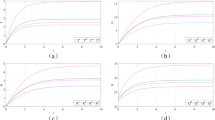Abstract
This article studies the price competition and cooperation in a duopoly that is subjected to carbon emissions cap. The study assumes that in a departure from the classical Bertrand game, there is still a market for both firms’ goods regardless of the product price, even though production capacity is limited by carbon emissions regulation. Through the decentralized decision making of both firms under perfect information, the results are unstable. The firm with the lower maximum production capacity under carbon emissions regulation and the firm with the higher maximum production capacity both seek market price cooperation. By designing an internal carbon credits trading mechanism, we can ensure that the production capacity of the firm with the higher maximum production capacity under carbon emissions regulation reaches price equilibrium. Also, the negotiation power of the duopoly would affect the price equilibrium.






Similar content being viewed by others
References
Benjaafar S, Elhafsi M (2012) A production-inventory system with both patient and impatient demand classes. IEEE T Autom Sci Eng 9:148–159. doi:10.1109/tase.2011.2158645
Benjaafar S, Li Y, Daskin M (2013) Carbon footprint and the management of supply chains: insights from simple models. IEEE T Autom Sci Eng 10:172–179. doi:10.1109/tase.2012.2203304
Calzadilla A, Rehdanz K, Tol RSJ (2011) Trade liberalization and climate change: a computable general equilibrium analysis of the impacts on global agriculture. Water 3:526–550. doi:10.3390/w3020526
Changsong M, Xu C, Zhenyu L (2015a) Production strategy of considering low carbon emission policies regulation under stochastic demand. Control and Decision 30:969–976
Changsong M, Zhenyu L, Tian L (2015b) Production strategy considering mandatory carbon emission policies regulation under stochastic demand. Syst Eng 33:61–64
Choi SC (1991) Price competition in a channel structure with a common retailer. Market Sci 10:271–296. doi:10.1287/mksc.10.4.271
Hong Z, Chu C, Yu Y (2012) Optimization of production planning for green manufacturing. In: 2012 9th IEEE International Conference on Networking, Sensing and Control (ICNSC). IEEE, Piscataway, NJ, pp 193–196
Hongguang P (2013) Optimal subsidy policy for accelerating the diffusion of green products. Journal of Industrial Engineering and Management 6:626–641. doi:10.3926/jiem.734
Wenlong C, Huijun S, Wei W, Jianjun W (2013) Price competition model in decentralized and centralized supply chains with demand disruption. Journal of Industrial Engineering and Management 6:16–24. doi:10.3926/jiem.616
Wu X (2012) Bertrand model overview. Industrial & Science Tribune 11:75–76
Author information
Authors and Affiliations
Corresponding author
Additional information
Responsible editor: Philippe Garrigues
Rights and permissions
About this article
Cite this article
Jian, M., He, H., Ma, C. et al. Reducing greenhouse gas emissions: a duopoly market pricing competition and cooperation under the carbon emissions cap. Environ Sci Pollut Res 26, 16847–16854 (2019). https://doi.org/10.1007/s11356-017-8767-1
Received:
Accepted:
Published:
Issue Date:
DOI: https://doi.org/10.1007/s11356-017-8767-1




